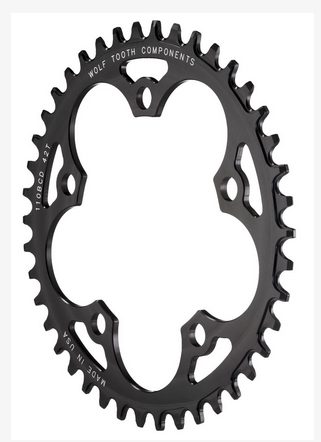
Wolf Tooth Components 110 BCD 40T Cyclocross Chainring
Intended Use: Cyclocross
Size Tested: 40 Tooth
MSRP (40 tooth): $79.00
Locations Tested: Whitefish, MT; Seattle, WA
Days Ridden: ~ 30
Tester Info: 6’1″, 185 lbs.
Unless you’ve been hiding under a rock during the last two mountain bike seasons (or perhaps strictly riding on the road), you’re probably aware of the explosion of “1X” drivetrains spurred on by the SRAM XX1 mountain bike group. The credit for this collective overthrow of the front derailleur can more or less be given to two different technologies—the narrow/wide alternating chainring and the clutch-style rear derailleur.
This year, there were a wide range of such offerings for mountain bikers from companies including SRAM, Wolf Tooth, and Raceface. We actually ran a review earlier this year on Wolf Tooth’s 104 BCD 32T chainring for mountain bikes.
Now, the industry is starting to realize (thankfully) that this technology will also be welcomed by the growing hordes of avid cyclocross racers.
Single Ring Set-Ups for Cyclocross
Cyclocrossers have been playing around with single ring set-ups for years, usually with some combination of an outer guard in place of the big ring and an upper guide or chain catcher. Even with this combination, there was some risk of losing a chain, and it’s this risk of chain drop that’s historically kept single ring set-ups from being very popular. But that’s changing.
Tech
Narrow wide chainring technology alternates the width of each tooth, effectively grabbing the chain as it passes over the teeth. Wolf Tooth Components are precision CNC machined in Minneapolis, Minnesota with the company’s own “Drop Stop” technology. The rings are milled from 7005 aluminum, then anodized in black and laser etched with the Wolf Tooth name. Ten speed chains mesh securely on the ring, and 11 speed chains will work just fine according to the manufacturer.

The Ride
The test mule for this ring was a 2014 Kona Major Jake carbon cyclocross bike. I swapped out the Notubes Ironcross wheels for a custom set with Crest rims and purple Chris King hubs, but other than those changes, the bike is basically stock. The switch to a disc brake-equipped cross bike has been very welcome this fall, but that’s a different story…
When I made the switch to 1X, I opted not to run any sort of front guide or chain watcher, mainly to see if the chain would stay on without assistance. And overall, I was pleased with how well the Wolf Tooth held onto the chain—I never experienced any drops in riding or racing with this set-up.
Noise and friction were both minimal, which I appreciated. With the 40-tooth size, I also noticed I would spend more time riding in the “sweet spot” of the cassette (e.g. not cross chaining all the time).
I found that switching to a smaller single ring set-up gives you quicker acceleration out of low speed corners. Instead of having to fumble around with front shifting, which can be a chore in muddy conditions, a single ring set-up offers near instant power without being overgeared, as can happen in the big ring.
Unless you’re one of the handful of SRAM athletes running the prototype “CX1” group this season, the Wolf Tooth narrow/wide cross ring is currently your best bet if you want a reliable single ring cross set-up. I imagine other manufacturers will be getting on this CX-specific bandwagon soon though…
Gear Range
If you’re considering a single ring set-up for cyclocross, you should think about how much you plan on racing the bike versus just riding it. On race day, a single ring almost always has a sufficient gear range. If you run out of gears, you’re probably better off just running the hill.
However, if your cross bike is also your go-to dirt road rambler, you will likely miss the lack of range on a long climb. My bike came equipped with a Shimano Ultegra 6700 group with a 12-28 cassette, which is about as much range as you can ask of that rear derailleur. If you happen to be running a SRAM drivetrain, their Red WiFly rear derailleur can accommodate an 11-32.
I should also note that the current generation of Shimano and SRAM offerings (including the Ultegra 6700 rear derailleur spec’d on my bike) do not have a clutched derailleur like many off-road versions do. As I mentioned earlier, I didn’t experience any chain drop with a standard rear derailleur, but that’s not to say it couldn’t happen. I have to give kudos to SRAM for their preliminary work on a dedicated 1×11 cyclocross version of their XX1 drivetrain. When that technology becomes readily available I would expect to see a huge bump in the popularity of single ring cross set-ups.
Bottom Line
If you’re looking for a relatively inexpensive switch to a 1X setup for your cyclocross bike (actually, it’s almost free if you sell your front derailleur to subsidize the cost), the Wolf Tooth narrow / wide ring is a solid bet. In my experience, the chain has a very high probability of staying on this ring with no other guide installed.
